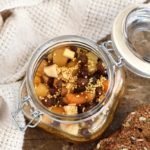Mostarda Fermentada
Mostarda is a sweet and spicy Italian condiment. It is traditionally served with meat, but it is also delicious with cheese or in a sandwich. The fermented version is a simple, no-cook recipe!
- Prep Time: 15 minutes
- Cook Time: 15 minutes
- Total Time: 30 minutes
- Yield: 1 1/4 cup 1x
- Category: Condiment
- Method: Fermented
- Cuisine: Italian
- Diet: Gluten Free
Ingredients
Units
Scale
- 3/4 cup mixed dried fruit (see notes)
- 1/2 cup hard green apple
- 3 Tbsp mustard seed
- 1/4 cup raw honey (see notes)
- 1/2 cup of water, to cover (chlorine-free)
Instructions
- Chop up the dried fruit and the apple. Mostarda is traditionally made from bite-sized chunks, but finely diced is also fine.
- Place the fruit in a pint-sized (2 cup) jar. Add in the mustard seeds and honey. Pour over the water. Press the fruit down in the jar. There should be enough water to cover the fruit, if not add a few more spoonfuls.
- Cap the jar with a lid that can handle the carbonation of fermentation (see notes). Place the jar in a dark location. A kitchen cupboard is perfect.
- The fruit and mustard will float, however, I’ve found a weight doesn’t help as the mustard will just escape around the sides. Instead, of using a weight, simply stir the mostarda once or twice during fermentation (after 12 or 24 hours). Let the mostarda ferment for 2 to 4 days.
- Store the mostarda in an airtight container in the fridge. It will be sparkling and sweet for the first week or so, then become more mellow and acidic over time. Enjoy within 4 to 6 weeks.
Notes
- I recommend using a mix of dried fruits: dried plums, cherries, apricots, currants and raisins are nice. The only trick is to find sulfite-free fruits, as the sulfites will prevent fermentation.
- Honey is the starter culture in this ferment. Look for honey that is labeled as unpasteurized or raw so that its natural yeasts and bacteria can ferment the fruit.
- This ferment can be capped with an untightened jar lid. This will keep out fruit flies and other bugs and is sufficient for a short ferment. If you are concerned about issues with mold and other contaminates use a fido jar or pickle pipe instead.
- Because of the health risks associated with the consumption of raw honey, this ferment is not recommended for pregnant women, children under the age of 1 year, or anyone who may be immunocompromised.
Find it online: https://www.fermentingforfoodies.com/mostarda/
